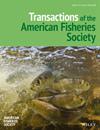与鳟鱼衰退有关的鳃虱体外寄生虫的分子鉴定和环境DNA检测
IF 1.4
3区 农林科学
Q2 FISHERIES
引用次数: 0
摘要
摘要目的鳃虱(Salmincola spp.)是淡水鲑鱼中最广泛报道的寄生虫之一,并与近年来本地鳟鱼Salvelinus fontinalis种群的下降有关。有效的鳃虱监测对鲑鱼保护的成功至关重要,但目前的调查方法往往不充分或有问题。在美国威斯康辛州Fort McCoy,我们开发了一种基于环境DNA (eDNA)的方法来检测edwardsii鳃虱,并探索了这种方法作为快速、大规模监测鳃虱的管理工具的可行性。方法从Fort McCoy采集的鳃虱标本中生成参考序列,确定其为S. edwardsii,并设计针对S. edwardsii线粒体细胞色素c氧化酶I (COI)的定量聚合酶链反应(qPCR)方法。分析验证包括硅和体外敏感性和非靶特异性测试,并通过在电钓表征的位点取样eDNA来原位验证分析性能。结果对参考序列的分子分析证实了S. edwardsii的同源性,并首次对北美Salmincola进行了多种群遗传变异评估,获得了迄今为止最全面的Lernaeopodidae分子系统发育。edwardsii在38个位点中的14个检测到eDNA,包括已知活跃侵染的14个位点中的12个,没有证据表明通过电钓检测到鳃虱的几率大于通过eDNA分析检测到的几率。布鲁克鳟鱼的存在高度预测了鳃虱eDNA位点的占用,这与S. edwardsii是Salvelinus鱼类的专性寄生虫一致。然而,通过eDNA分析扩大调查范围,我们能够识别出布鲁克鳟鱼的孤立排水,其中明显没有S. edwardsii,证实了电钓观察结果。结论eDNA分析在检测鳃虱的性能上与电钓相当,但在调查效率上有很大的提高。此外,本研究表明,eDNA分析可以为指导管理工作提供有价值的信息,特别是当用于扩大调查范围和优先跟进传统调查以评估宿主-寄生虫丰度、人口统计和状态时。本文章由计算机程序翻译,如有差异,请以英文原文为准。
Molecular identification and environmental DNA detection of gill lice ectoparasites associated with Brook Trout declines
Abstract Objective Gill lice Salmincola spp. are among the most widely reported parasites of freshwater salmonids and have been associated with recent declines in native Brook Trout Salvelinus fontinalis populations. Effective gill lice surveillance is vital for salmonid conservation success, but current survey approaches are often inadequate or problematic. We developed an environmental DNA (eDNA)‐based approach to detect the gill louse Salmincola edwardsii and explored the viability of this approach as a management tool for rapid, large‐scale gill lice surveillance at Fort McCoy, Wisconsin, USA. Methods Reference sequences were generated from gill lice specimens collected at Fort McCoy to confirm their identify as S. edwardsii and used to design a quantitative polymerase chain reaction (qPCR) assay that targets S. edwardsii mitochondrial cytochrome c oxidase I (COI). Assay validation included in silico and in vitro sensitivity and nontarget specificity testing, and assay performance was validated in situ by sampling eDNA at sites characterized via electrofishing. Result Molecular analysis of reference sequences confirmed S. edwardsii identity while also providing the first multi‐population assessment of genetic variation for North American Salmincola and the most taxonomically comprehensive molecular phylogeny of Lernaeopodidae to date. Salmincola edwardsii eDNA was detected at 14 of 38 sites, including 12 of 14 sites with known active infestations, with no evidence that the odds of detecting gill lice via electrofishing was greater than the odds of detections from eDNA analysis. Brook Trout presence was highly predictive of gill lice eDNA site occupancy, concordant with S. edwardsii being an obligate parasite of Salvelinus fishes. However, by expanding survey coverage via eDNA analysis, we were able to identify an isolated drainage with Brook Trout where S. edwardsii is apparently absent, confirming electrofishing observations. Conclusion These results suggest that eDNA analysis is equivalent to electrofishing for detecting gill lice in terms of performance yet offers substantial gains in survey efficiency. Further, this study demonstrates how eDNA analysis can provide valuable intel for directing management efforts, especially when used to expand survey coverage and prioritize follow‐up conventional surveys to assess host–parasite abundance, demographics, and status.
求助全文
通过发布文献求助,成功后即可免费获取论文全文。
去求助
来源期刊
CiteScore
2.90
自引率
7.10%
发文量
48
审稿时长
8-16 weeks
期刊介绍:
Transactions of the American Fisheries Society is a highly regarded international journal of fisheries science that has been published continuously since 1872. It features results of basic and applied research in genetics, physiology, biology, ecology, population dynamics, economics, health, culture, and other topics germane to marine and freshwater finfish and shellfish and their respective fisheries and environments.

 求助内容:
求助内容: 应助结果提醒方式:
应助结果提醒方式:


